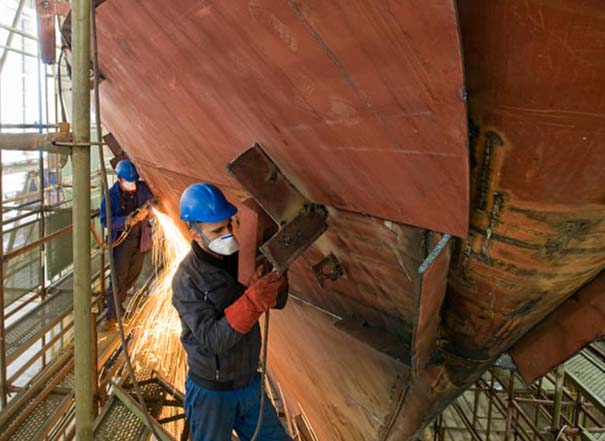Debate sobre las bobinas de acero al carbono
377Las bobinas de acero al carbono son materiales versátiles y duraderos que se utilizan en la industria manufacturera, la construcción y la automoción para diversas aplicaciones.
Ver detallesBuscar en toda la estación
When working with ship repair, shipbuilding contractors, or offshore fabrication, the challenge is often not capacity, but sourcing the right marine grade steel plate in small or mixed batches. Projects rarely follow textbook material consumption. Unexpected replacement, sectional repair, and scheduled maintenance can require 1–50 tons, sometimes urgently.
This guide is written for ship repair yards, offshore fabrication workshops, and regional steel distributors who often face small-batch and mixed-size procurement needs. In these environments, project schedules are tight, classification certificates must match batch numbers, and delivery time is often more critical than mill-origin supply.
Sourcing Small Batches of Certified Ship Plate? We Deliver.
CJM specializes in supplying AH36, DH36 & EH36 steel plates with full certification (ABS, LR, BV, DNV) for ship repair and offshore projectscon flexible MOQs and fast turnaround.

Para más información sobre la selección de materiales, consulte nuestra guía:
👉 ¿Qué chapas de acero se recomiendan para los proyectos de construcción naval y en alta mar?.
The main difference is impact test temperature, which relates to toughness performance under colder working conditions.
| Grado | Impact Test Temperature | Typical Usage Scenario |
|---|---|---|
| Acero AH36 | 0°C | General hull structure, decks, stiffeners |
| Acero DH36 | -20°C | Ships in colder waters, enhanced decks and bulkheads |
| Acero EH36 | -40°C | Plataformas marinas, deep-sea equipment, high-strength load-bearing parts |
| Grado | C | Mn | Si | P (máx) | S (máx) | Nb/V/Ti (Microalloy) |
|---|---|---|---|---|---|---|
| AH36 / DH36 / EH36 | ≤0.18 | 0.90-1.60 | 0.10–0.50 | 0.035 | 0.035 | Allowed (for strength & toughness) |
| Grado | Límite elástico (MPa) | Resistencia a la tracción (MPa) | Alargamiento (%) |
|---|---|---|---|
| AH36 / DH36 / EH36 | ≥355 | 490-620 | ≥21 |
| Espesor | Anchura | Longitud | Supply Notes |
|---|---|---|---|
| 6–50mm | 1500–3200mm | 6000-12000 mm | Typical available specifications, mixed sizes allowed |

Shipbuilding plate should match the required classification standard:
| Clasificación | Common Regions / Uses |
|---|---|
| ABS | Global commercial and cargo fleets |
| LR / BV | Europe, Africa, Middle East marine markets |
| DNV | Offshore engineering and Northern Europe operations |
If working on classed ship parts, the certificate must match the steel grade and heat number used.
| Grado de acero | Comparable Materials | Replaceability Notes |
|---|---|---|
| AH36 | Q345 / S355 | Can be substituted in non-classed general marine fabrication |
| DH36 / EH36 | Higher notch toughness variants | Must follow ship classification requirements; matching certificate is critical |
If the steel forms part of a class-inspected structure, do not substitute without classification approval.
When choosing among AH36, DH36, and EH36 steelConsidéralo:
Even small quantity supply must still meet the traceability and certification required for marine work.
If you are working with:
We can support 1–50 ton flexible MOQ, ABS / LR / BV / DNV certificationy cut-to-size processing suitable for urgent and mixed-size delivery.
WHY CJM:
WhatsApp: +86 181 9190 6640
Correo electrónico: info@cjmstainlesssteel.com
Las bobinas de acero al carbono son materiales versátiles y duraderos que se utilizan en la industria manufacturera, la construcción y la automoción para diversas aplicaciones.
Ver detallesExplore las opciones exactas de chapa de acero a cuadros para escaleras, remolques y suelos de fábricas. Compare por grosor, diseño y precio. Guía de expertos de CJM.
Ver detallesConozca qué son los perfiles de acero al carbono, sus principales tipos (viga en I, canal, ángulo), propiedades y usos industriales. Encuentre proveedores fiables de perfiles de acero al carbono.
Ver detallesDescubra los tipos, diseños, tamaños y materiales de las chapas de acero a cuadros utilizadas en la construcción, las pasarelas y los suelos industriales. ¡Una guía completa para usted!
Ver detalles
HolaConéctese